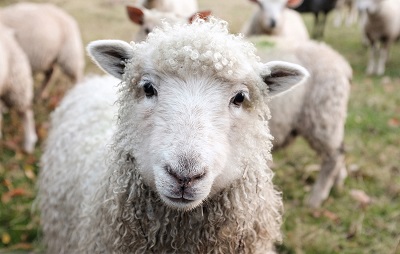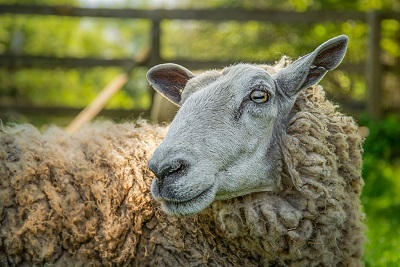Wool eating or Wool biting Sheep
Sheep eating other sheep’s wool is a behavior known as “wool eating” or “wool biting.” While this behavior is not common and occurs more frequently in captive or domesticated sheep, there are several reasons why it might happen:
Nutritional deficiency: In some cases, sheep may develop mineral or nutrient deficiencies that lead them to seek alternative sources of nutrition. Wool contains small amounts of protein and minerals, and a sheep experiencing deficiencies may try to supplement its diet by consuming wool.
Boredom or stress: Sheep are social animals that thrive in flocks. When sheep are isolated or confined without adequate mental stimulation, they may develop abnormal behaviors, including wool eating. Boredom and stress can drive sheep to engage in this behavior as a coping mechanism.
Learned behavior: In some instances, one sheep may start to nibble on another sheep’s wool, and other sheep may imitate the behavior, considering it normal. This can lead to a contagious habit within the flock.
Genetic predisposition: Some sheep may have a genetic predisposition to wool eating. This tendency can be passed on through breeding, making certain individuals more likely to engage in the behavior.
Wool eating can be problematic as it can lead to health issues for the sheep. Consuming wool can cause blockages in their digestive system, leading to discomfort and potentially serious health complications.
To prevent wool eating, it’s essential to ensure that sheep receive a well-balanced diet with adequate nutrition and access to appropriate forage. Providing a stimulating environment with sufficient space, social interaction, and enrichment can also help reduce stress and abnormal behaviors in sheep. If wool eating becomes a significant issue in a flock, consulting a veterinarian or a qualified animal behavior expert is recommended to address the underlying causes and find appropriate solutions.
As shepherds and sheep enthusiasts, we are familiar with the gentle and docile nature of these fluffy creatures. However, occasionally, a rather unusual behavior is observed among sheep: wool-eating. Yes, it may sound surprising, but there have been instances where sheep have resorted to consuming the wool of their fellow flock members. In this blog post, we delve into the reasons behind this seemingly bizarre behavior and explore the possible explanations.

Nutritional Deficiencies
One of the primary reasons why sheep may resort to eating wool is the presence of nutritional deficiencies in their diet. Sheep require a balanced diet with adequate amounts of proteins, vitamins, and minerals to maintain their health and well-being. When their nutritional needs are not met, they may develop a condition called “pica,” which leads to abnormal cravings for non-nutritive substances, such as wool. Lack of certain essential nutrients, especially proteins and trace minerals, could be a contributing factor to this behavior.
Boredom and Stress
Believe it or not, sheep can experience stress and boredom, just like any other animal. Sheep are social animals that thrive in the company of others. When they are kept in confinement or isolated from their flockmates for extended periods, they may resort to wool-eating as a form of self-soothing or out of sheer boredom. This behavior could also manifest in response to other stressful situations, such as sudden changes in their environment or routines.
Learned Behavior
In some cases, wool-eating may start with just one sheep in a flock and then spread to others through a process of learned behavior. Sheep are known to imitate each other, and if one sheep discovers that consuming wool alleviates certain discomforts or stress, others may follow suit. This learned behavior can quickly become a habit, leading to a widespread issue within the flock.
Hormonal Imbalances
Hormonal imbalances can also contribute to abnormal behavior in sheep, including wool-eating. Hormonal changes due to factors such as pregnancy, lactation, or certain health conditions may influence the sheep’s appetite and lead them to seek alternative food sources, like wool.
Lack of Roughage
A diet that lacks sufficient roughage can also be a reason behind wool-eating in sheep. Roughage, such as hay and fibrous plants, plays a crucial role in the digestion process, ensuring the proper functioning of the rumen. If sheep do not have access to enough roughage, they may attempt to compensate by chewing on wool, which can lead to severe health issues like wool block.
While wool-eating in sheep may appear peculiar and even concerning, it’s essential to understand the underlying reasons behind this behavior. Addressing the root causes can help prevent its occurrence and ensure the well-being of the flock. Providing a balanced diet, access to roughage, and a stress-free environment can significantly reduce the likelihood of sheep resorting to wool consumption. As responsible shepherds, it is crucial to keep a close eye on our flocks and take prompt action if any such behavior is observed.
Let us remember that sheep, like all living creatures, deserve our care and attention to lead happy and healthy lives. By understanding their needs and behaviors, we can continue to enjoy the companionship of these charming animals for generations to come.
YouTube Channel: Farming South Africa
Facebook Page: Farming Life
Back To Home Page: Farming South Africa

